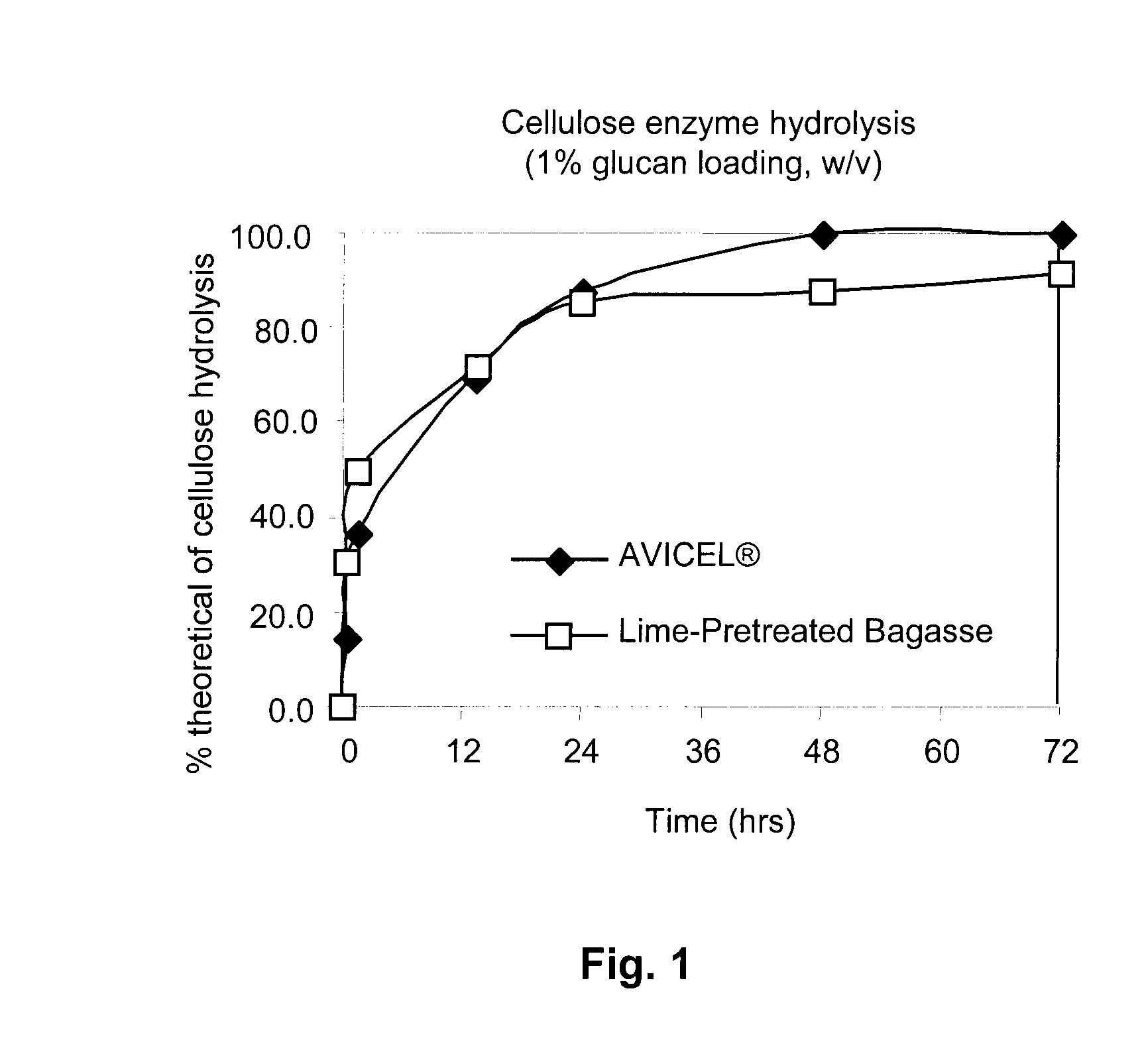Process for Sugar Production from Lignocellulosic Biomass Using Alkali Pretreatment
a technology of lignocellulosic biomass and pretreatment method, which is applied in the direction of biofuels, fermentation, etc., can solve the problems of low material cost, relatively short processing time, post-treatment sterilization, etc., and achieves low material cost, high loading, and prevent the inhibition of enzymes used
- Summary
- Abstract
- Description
- Claims
- Application Information
AI Technical Summary
Benefits of technology
Problems solved by technology
Method used
Image
Examples
example 1
Materials and Methods
[0022]Lignocellulosic Material. Sugarcane bagasse (bagasse) was collected from a sugarcane bagasse pile at a local sugar mill in Louisiana. The bagasse was used “as-is”, with sizes ranging from about several millimeters to about 10 cm length. All weights were based on dry weights, where the obtained weight was corrected by using a moisture analyzer at 105° C. (Computrac MAX 1000, Arizona Instrument Corporation, Tempe, Arizona) to determine retained moisture.
[0023]Treatment with Lime. Bagasse was mixed with hydrated lime powder (Ca(OH)2; Fisher Scientific, Fair Lawn, N.J.), and then deionized water was added to produce the desired bagasse to water ratio and bagasse to chemical loading ratio. For example, 1 g of dry solid bagasse was mixed with 0.2 g of dry solid lime powder and with 10 g of deionized water to make a 1:10 bagasse to water ratio and a 1:0.2 bagasse to lime loading ratio. This mixture was heated to 121° C. for 1 hr in an autoclave. Immediately after...
example 2
Composition of Bagasse Before and After Lime Treatment
[0031]The lime-pretreated fibrous material after milling (or pressing) contained 60 to 70% dry solids. The composition of the bagasse before and after the lime treatment and pressing was determined as described above by the NREL procedure. The results are shown in Table 1.
TABLE 1Composition analysis of bagasse before andafter lime treatment (% dry wt)GroupComponentsRaw bagassePretreatedCelluloseGlucan30.334.1Hemi-Xylan19.217.9CelluloseArabinan1.21.3Mannan0.50.5LigninAcid-insoluble lignin24.516.6Acid soluble lignin5.04.7Total lignin29.521.3Ash2.58.7Total87.490.2
[0032]The treatment with lime and pressing apparently did not remove either the cellulose or hemicelluloses, only a large percent of the lignin. About 93% (w / w) of the xylan was retained, but the other minor sugars did not change concentration. However, the process removed 28% of the lignin. In one experiment, an increase of ash content was observed possibly due to calcium ...
example 3
Cellulose Enzyme Hydrolysis to Glucose at 2.5% Solid Loading
[0033]Although most studies use cellulase loadings for hydrolysis of less than 40 FPU / g of glucan, because sugarcane bagasse is more recalcitrant than corn stover, a higher dose of enzymes was used in this experiment. Chang et al. (1998) reported that sulfuric acid was not effective for pH adjustment and enzyme hydrolysis in their lime treatment of biomass, and used glacial acetic acid to lower the pH. However, they reported an inhibitory effect on the cellulases due to calcium acetate that was formed as salt concentration increased. Another group reported that the calcium acetate from pH adjustment with glacial acetic acid did not affect the enzyme activity against corn stover (Karr, William E., and Holtzapple, Mark T., 2000. Using lime pretreatment to facilitate the enzyme hydrolysis of corn stover. Biomass and Bioenergy, 18: 189-199). However, in our experiment, sulfuric acid was found to be an effective pH reducing agen...
PUM
| Property | Measurement | Unit |
|---|---|---|
| size | aaaaa | aaaaa |
| size | aaaaa | aaaaa |
| size | aaaaa | aaaaa |
Abstract
Description
Claims
Application Information
 Login to View More
Login to View More - R&D
- Intellectual Property
- Life Sciences
- Materials
- Tech Scout
- Unparalleled Data Quality
- Higher Quality Content
- 60% Fewer Hallucinations
Browse by: Latest US Patents, China's latest patents, Technical Efficacy Thesaurus, Application Domain, Technology Topic, Popular Technical Reports.
© 2025 PatSnap. All rights reserved.Legal|Privacy policy|Modern Slavery Act Transparency Statement|Sitemap|About US| Contact US: help@patsnap.com



